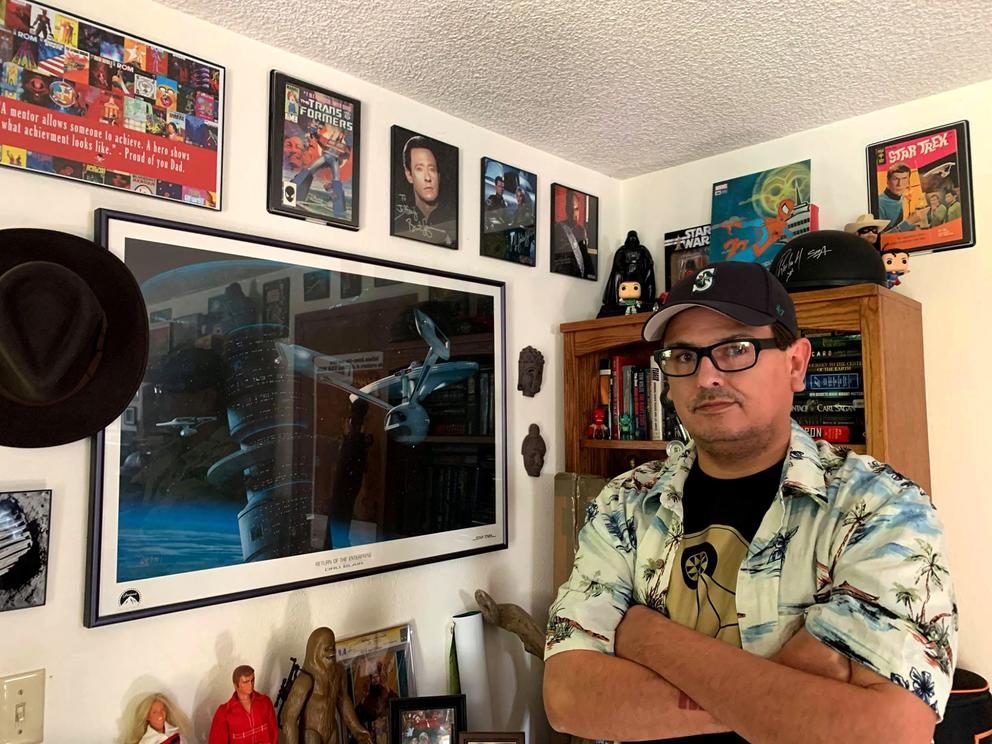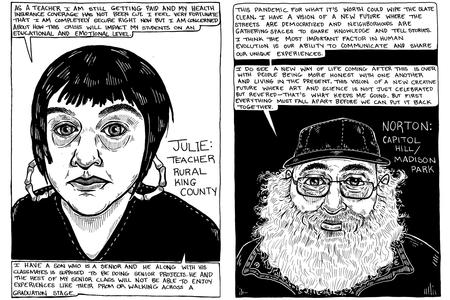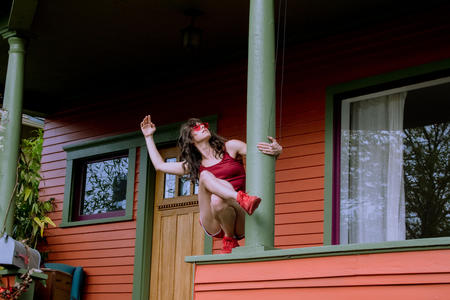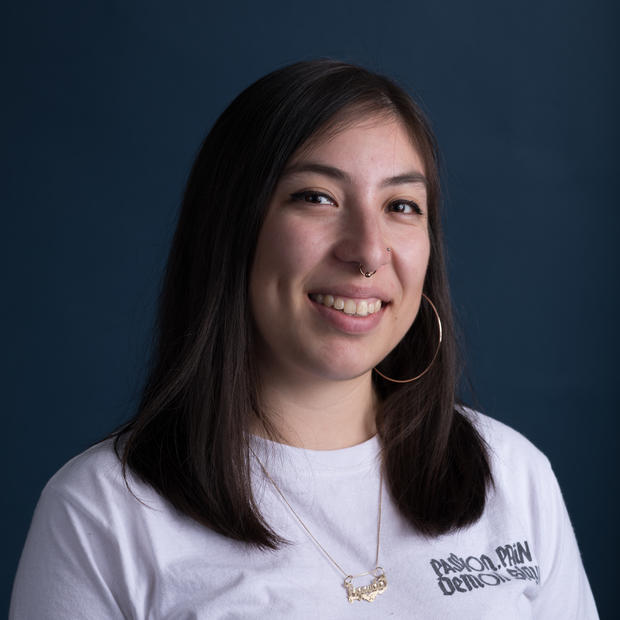“We are in a dark time as a country, divided and angry,” Veregge, 46, wrote in the exhibition text. “I want an art show that brings us back to a time of hope, bravery and imagination.” Now, in the midst of a global pandemic, his words seem more pertinent than ever.
This week he returns to Stonington with a new show called A Better Tomorrow (online starting May 14) that echoes similar themes. But instead of flight, Veregge is setting his sights on the Space Age — specifically as it was embodied by the 1962 World’s Fair. Like the era explored in these new works, the show arrives during a defining point in world history.
Read about the Seattle illustrator documenting the impact of coronavirus by way of reportorial comics.
A member of the Port Gamble S’Klallam Tribe, Veregge says his artistic style is “Salish geek.” A lifelong fan of Star Trek and other science fiction, he combines ancient art traditions with modern day pop culture. Previous work has portrayed comic book heroes (Batman, Superman, Flash), and sci-fi movie icons (R2D2 and the Millennium Falcon from Star Wars, Xenomorphs from the Alien series) in ways they’ve never before been seen.
His digital illustrations use common design elements of Coast Salish formline — curved shapes known as ovoids, crescents, trigons and circles that incorporate negative space to create a silhouette — and adds an appealingly mod, cartoonish flair. In the 11 new works, Veregge depicts the architecture seen at Seattle Center, such as the Space Needle, the sleek arches of Pacific Science Center and the monorail, amplifying it with astronauts, floating cars and elements of the Pacific Northwest’s natural beauty.
“People have an idea of what Native art is and what Salish art is,” Veregge says. “I want people to see that it can be contemporary in a way that still honors the intention of the form and the storytelling, but in a way that it is new and unexpected.”
Learn how Seattle theaters are adapting for coronavirus concerns — from sparse seating to masked actors.
It’s a style that has gained Veregge acclaim — and plenty of work. In 2015, he was tapped by Marvel Comics to illustrate the covers for the revival series of the company’s first Native American comic book hero, Red Wolf. Later this year, Veregge will unveil a huge wraparound mural commissioned by the new Citizen M Hotel in South Lake Union. Perhaps appropriate, given the high-tech neighborhood, the 120-by-20-foot piece, called “Eye of Prime,” depicts artificial intelligence as a savior, not threat, to the human race. In it, a godly six-armed Optimus Prime delivers knowledge to robots and droids via a third eye.
Other projects on the horizon include a mural for the new Seattle Center Arena and a collaborative installation with sculptor Jonathan Clarren that employs steel sheets to adorn a new apartment project at 12th Avenue and Yesler Way in the Central District.
For his current series at Stonington, Veregge wanted to tap into the boundless imagination people had during the 1960s, when technological and civic possibilities were fueled by space exploration and psychedelics. Enter the 1962 World’s Fair, which signaled to the world that the future was seated in Seattle.
“America had this bright future still, and they looked ahead at the possibilities,” Veregge says of the era. “The minds and imaginations of the public at large were in a much more cheerful and hopeful disposition. It was unfettered.”
In one piece, "Reaching for Space,” two astronauts fly up toward ringed planets on either side of the Space Needle, where the tophouse is transformed into the face of a totem. Just below the astronauts’ feet are the customary ovals and crescents — originally meant to symbolize ripples moving through calm water.
“To me, this was a really organic merger of those,” Veregge says, referring to the blend of World's Fair themes with his Salish style.
Another piece, “Road to the Future,” showcases what was once heralded as the transportation of tomorrow. Surrounded by candy-bright yellows, pinks, greens, purples and blues, the monorail snakes through what resembles a Chutes and Ladders board game, its track supported by trigon pillars.
In a world without the coronavirus, Stonington Gallery would open its doors for a festive reception, where patrons view the art and chat about Veregge’s unusual technique. But for now, gatherings are limited to the online world, via the once futuristic communication technology known as Wi-Fi.
For any artist, the lack of a real-world exhibit is disappointing. But if humans can send a man to space, surely we can view art from home.
“I don’t mind, especially since technology is a part of this,” Veregge says. “I do miss being able to interact with people … but it is what is and I still have the opportunity to share my art.”
He notes the pandemic has brought him closer to one group of people: his family. “I’m being much more present in my home with my family,” Veregge says. “I think that in spite of everything that's going on, this is a rare gift.”
His sons have helped create videos of their father discussing each piece, which will appear on Stonington’s website. The footage is a window onto Veregge’s process, which includes hours of research and moments of inspiration sketched on whatever is handy — a notebook, loose leaf paper or napkin.
A Better Tomorrow reminds viewers of a not-so-distant past, when people envisioned a future where not even the sky was the limit. During this time of sheltering in place, Veregge says a similar outlook is needed, though the race is not to space but toward a vaccine for coronavirus.
“Here in this situation, we can see that the generations before were working towards a better place,” Veregge says. “They wanted to see the future as a clean, smooth-running machine.” Looking even further back, he offers a deeper perspective: “We can look to our ancestors and take comfort knowing that they have lived through times just as harrowing or even more so than we did.”
Get the latest in local arts and culture
This weekly newsletter brings arts news and cultural events straight to your inbox.










